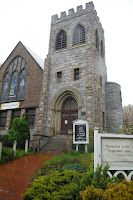 |
| Medford, in the upper left corner of this map, is just five miles from Boston's Financial District. The garden is located in that first 'e' in Medford. |
Three years ago, Joan Parker was feeling
frustrated. A long-time volunteer at a
church-run food cupboard in Medford, Massachusetts, each week she parceled out
canned and packaged foods to the mostly Haitian immigrants served by the
charity. While what she provided helped
needy families stretch meager resources, Joan felt she should be doing more.
It wasn’t that Joan didn’t know how to grow
vegetables. As a Master Gardener, Joan
helped maintain a 6,000-square-foot vegetable plot at the Elm Bank headquarters
of the Massachusetts Horticultural Society.
Most of the output of that garden made its way to food banks in towns
adjacent to Wellesley, where Mass Hort is located. Joan began to wonder if it might it be
possible to create such a garden in Medford, a city just a few miles north of
Boston’s Financial District?
 |
| Joan Parker |
At the Mass Hort garden, Joan worked alongside Susan
Hammond. (I should add at this juncture
I have known Susan for the better part of a decade. Susan was Betty’s ‘protégé’ and the person to
whom she handed off responsibility for that garden when Betty’s growing Garden
Club Federation responsibilities took her in a new direction.)
Joan and Susan talked about the potential challenges
of an urban, food-cupboard-oriented garden.
As it turned out, changes in the focus and direction of the Mass Hort
garden made that project less attractive to the volunteers who worked
there. The Medford project seemed like a
more freewheeling ‘re-boot’ for gardeners looking for a challenge.
 |
| The garden hugs one side of the church and several sites around the Rectory |
Joan and Susan set about to design a model garden
smack in the center of Medford. Their
sponsor was the Unitarian Church of Medford, a venerable institution that also
sponsored the food cupboard where Joan volunteered. Initial plans were for a very low budget
garden, funded by the volunteers, using the existing soil and adding
compost. The site would be the (mostly) sunny
lawn of the church rectory. Master Gardener
volunteers would run the garden. A few
hundred dollars seemed more than adequate to get the garden up and running, buy
seeds, all those sorts of things, and a drip irrigation system could wait for a
while.
 |
| Because the soil contains high levels of lead, all planting is in raised beds. That's Susan Hammond at right. |
Which was when reality reared its ugly head. The first problem was the site. The grass lawn turned out to be integral to
the church’s ministry. Groups met there and services were held there. Joan and Susan regrouped. They proposed a dispersed garden utilizing
bits and pieces of church property.
‘Terrific!’ was the response.
Soil tests were performed and plans were made to begin plowing up the
ground to start the garden.
Then, those soil tests came back. The soil contained toxic levels of lead. All that lead paint and lead from other
sources had left the ground utterly unsuitable for the growing of anything
planned for human consumption.
 |
| To ensure no bed lies fallow, these cups hold spaces where a squash crop will be planted next |
OK,
they concluded, we’ll do taller raised
beds. On further investigation, the
raised beds would need to be kept completely apart from the soil underneath
them. OK, they thought, double-height
raised beds with impermeable barriers between the beds and the soil.
There went the budget. However, there was still a need
for this garden, so the food pantry applied for and received a $1,000 grant
from the Massachusetts Master Gardener Association.
In the meantime, other Master Gardeners were eager to
start on the project. They surveyed food
cupboard recipients and got input on what kinds of fresh vegetables would be
most welcome. A request for exotic seeds
went to Master Gardener Deb Haley, who investigated and sourced Haitian
varieties. Master Gardener Gretel
Anspach provided access to large quantities of onions and leeks including
specialty cooking onions.
This weekend, I finally got to see the garden I’ve heard
about for three years. The Master
Gardeners opened it for visitors, and I was part of a tour group led by Susan
Hammond.
 |
| The ollas buried in these 'bag beds' provide continuous moisture to the vegetables growing there. |
The garden is a small masterpiece. It hugs one side of the church with raised
beds for vegetables and an in-ground perennial garden. Across the street at the rectory, three sets
of distinct vegetable beds ring that grass lawn while leaving the center
available for church functions. All the
tricks of the trade are used to coax the maximum production of vegetables from
the site, including succession planting and space holders for second crops even
as the first round are little more than seedlings. Ollas, ceramic jugs embedded in the soil,
provide continuous moisture because the drip irrigation system can be used only
when volunteers are present (the faucet upon which the drip system is dependent
has an unfortunate leak).
 |
| These handful of beds, with the help of ten volunteers, delivers a bounty of fresh produce every week. |
This year’s first distribution of vegetables – pea
greens – will be made in mid-May. Thereafter,
every week, a growing cascade of Haitian favorites comes to the food cupboard,
with ten volunteers working the garden on a regular schedule. The last distribution coincides with
Thanksgiving, when the last of the autumn cornucopia is handed out.
It is an urban success story; proof that, with
perseverance and resources, gardeners can overcome almost any obstacle. It isn’t ‘The Little Garden That Could’; it’s The Little Garden That Does.






